13 Unconventional Pasta Shapes You Should Know About
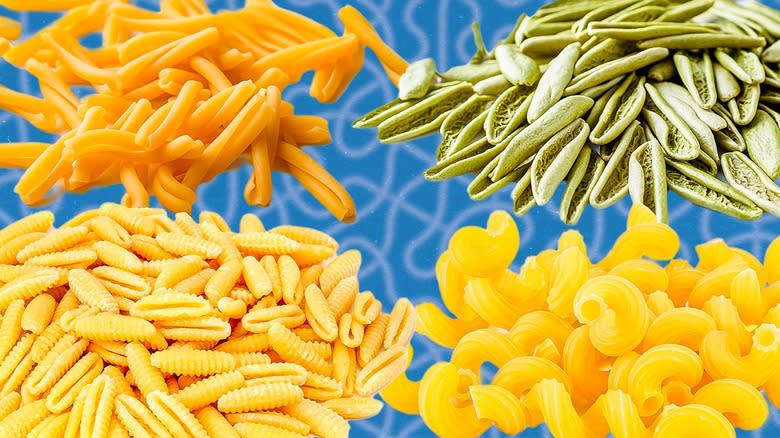
Italian cuisine is arguably one of the most popular in the world, renowned for its versatility and focus on fresh, seasonal ingredients. Pasta shapes and sauce combinations number well into the hundreds. Many pasta cuts in Italy are region-specific and have ancient roots tied to some of the country's most salient and unexpected bits of history. A handful of shapes were invented for reasons that extend beyond culinary delights -- several were instead initially used as tools for surprising, even shocking, reasons, such as murdering tax-collecting priests or smuggling garlic cloves across the Alps into 17th-century Austria, then known as Prussia.
While legends around origins abound, there's no denying that pasta is a delicious and filling addition to any meal. The number of cuts, big and small, wide and narrow, squat and long, are masters of sopping up sauces that pack a flavorful punch with each bite. And sometimes, it's the odd, whimsical-looking ones that do this better than others. Here are 13 unconventional pasta shapes and their unique histories you should know about.
Read more: Pasta Sauce Brands Ranked Worst To Best
Cavatelli
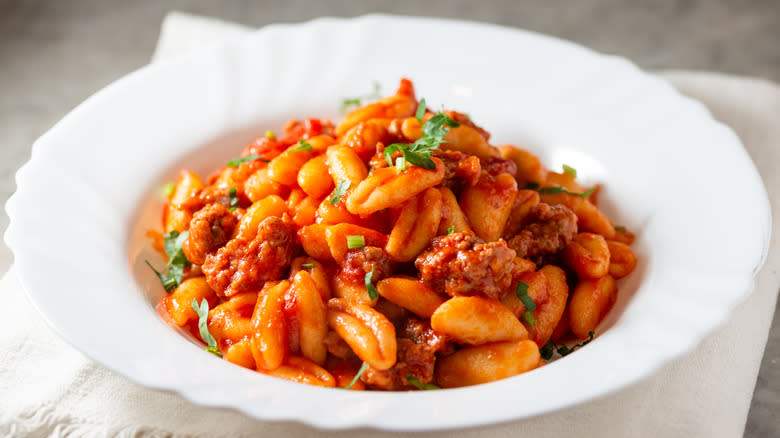
Despite being one of the oldest pasta shapes in Italy, cavatelli is a dark horse in the pasta game. Originating from the small region of Molise, located in central southern Italy, they are traditionally made with semolina, or any other kind of flour, and water. They are a simple shape that features a caved center that's perfect for latching onto the sauce. While the traditional shape is smooth, there are grooved variations that are formed by shaping the dough on a fork's prongs or with a rigagnocchi, a grooved cutting board.
While cavatelli is primarily associated with Molise, it also spread to neighboring regions such as Puglia, Abruzzo, and Basilicata, and belongs to the stracinate family, meaning "dragged," a group of southern pasta shapes formed by dragging one's fingers across a wooden surface. Once cooked, it's soft and chewy, resembling the consistency of gnocchi. This ancient pasta shape is traditionally served in a decadent ragù sauce heaped with pork ribs and sausage, although a common poor man's variation lacks the meat and is instead centered on a rich tomato sauce enriched with lard. More modern variations include cavatelli with pea shoot pesto.
Strozzapreti
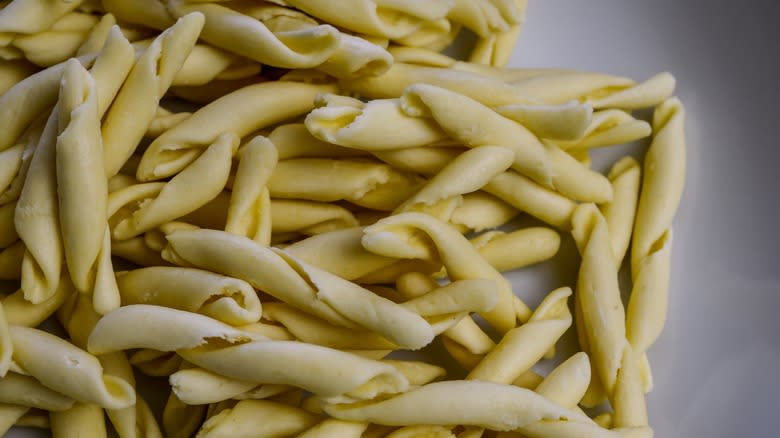
Translating to "priest strangler," strozzapreti is a unique pasta shape with a dark history. Made from a simple combination of water and flour, the long and thin twisted shape was likely born out of 19th-century common people's anger towards priests. Before the Kingdom of Italy's establishment in 1861, the northern region of modern-day Emilia-Romagna belonged to the oppressive Church-State and priests were its often unkind tax collectors. According to legend, the priests would collect taxes at lunchtime and demand to be fed while doing so. If the household was unable to provide them with a meal, the priests would then confiscate their eggs, a precious commodity and valuable source of protein for poor families.
Born out of a need to survive and perhaps a collective desire for revenge, the working class invented a pasta shape that did not require eggs and that could be fed to the tax-collecting priests in the hopes of choking them. The pasta's naturally twisted shape also bears an eerie resemblance to the ropes used to hang criminals. While this may only be a coincidence, it could very likely be a metaphorical manifestation of the common people's anger. Strozzapreti were traditionally dressed only in olive oil and cheese, but today they can be added to any sauce, from broccoli rabe to ragù.
Malloreddus
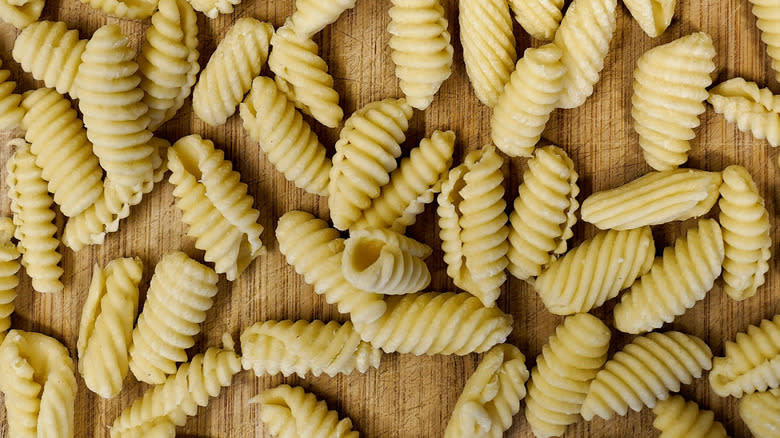
These small pasta shapes have ridged shells that resemble stylized gnocchi, hence why they're also referred to as gnochetti sardi, or little Sardinian gnocchi. Native to the sunny island of Sardinia, specifically the southern region of Campidano, they're shaped with a rigagnocchi, a grooved cutting board. The pasta has a chewy consistency, and its many ridges are ideal for scooping up and holding onto sauce. They're an integral part of Sardinian culture and are often served at holidays, village festivals, and weddings.
Malloreddus alla Campidanese is a popular dish made with a fragrant tomato, sausage, saffron, and fennel seeds ragù, but the pasta can be enjoyed in several ways. It's also consumed with bottarga, salt-cured fish roe also referred to as "Sardinian gold," and clams, or even simply with sharp Sardinian Pecorino cheese and wild fennel.
The origins of the pasta's names are up for debate: one popular theory argues it hails from the Latin word malleolus, meaning "little morsel"; while others champion a more adorable tale that it descends from the dialect word malloreddu, which means bull calf, to reference the pasta's pot-belly shape.
Trofie
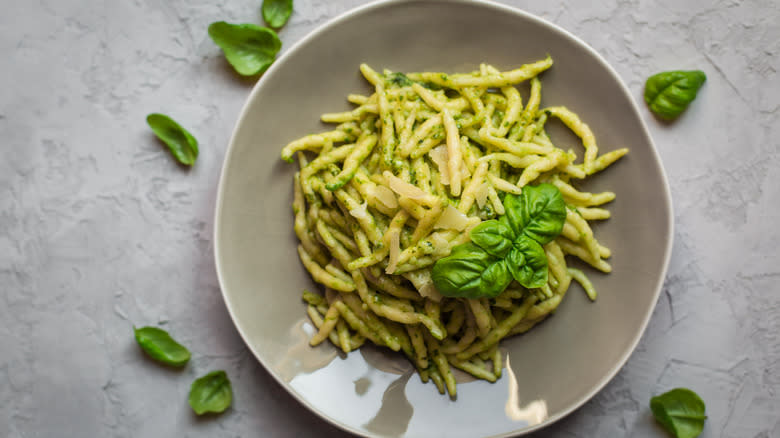
Trofie is perhaps the supreme pasta shape to pair with bright and fresh Pesto alla Genovese. Hailing from Genoa, a coastal town in the northern region of Liguria, the cut is thin and twisted with many little ridges that are perfect for sopping up plenty of pesto sauce. Made only with water and durum wheat semolina flour, a hard kind of flour that's high in protein and gluten, it's believed to have been created sometime in the 18th century. Legend has it that fishermen's wives used to sit along the harbor, twisting the pasta with their hands in anticipation and anxiety for their husbands to return safely from the sea.
While trofie is more famously associated with pesto, it's not exclusively married to the sauce. Another popular, traditional dish blends the pasta shape and pesto sauce with tender boiled potatoes and green beans to create a rustic meal packed with flavor.
Cappelletti
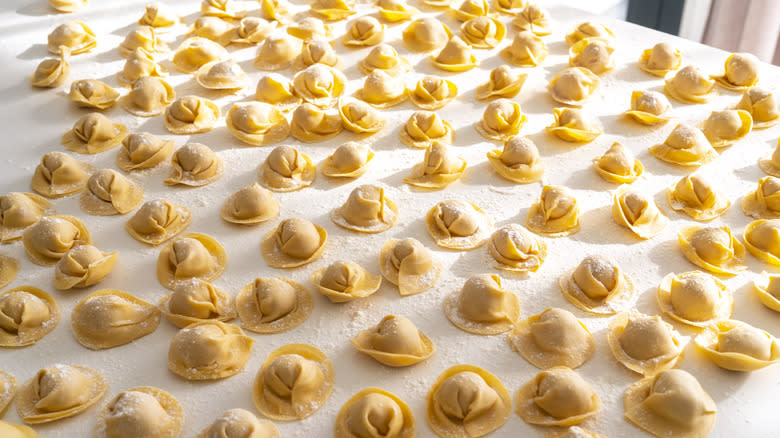
Translating to "little hats" in English, cappelletti is a stuffed pasta traditionally hailing from the regions of Emilia-Romagna and Marche that is named after the typical shape of medieval priest hats. While often compared to its perhaps more famous counterparts tortellini, cappelletti is thicker and doughier, and constitutes a hearty meal, especially when stuffed with proteins such as chicken and beef and cheeses like ricotta.
The first mention of cappelletti appears in a 13th-century food "Chronicle" penned by a priest by the name of Salimbene di Adam. It wasn't until the 16th century, however, that cappelletti hit its stride as a stuffed pasta recipe –- the shape was officially introduced into the culinary scene by Este court chefs Cristoforo di Messibugo and Bartolomeo Scappi.
While the traditional filling for the stuffed pasta has stoked controversy, with each region and town advocating for its own unique flavors, there is a consensus on the method by which cappelletti must be cooked. For a rich, fatty flavor, cappelletti is to be cooked in a brodo, or broth, enriched by capon, a rooster that is castrated before it matures.
Spaghetti Alla Chitarra
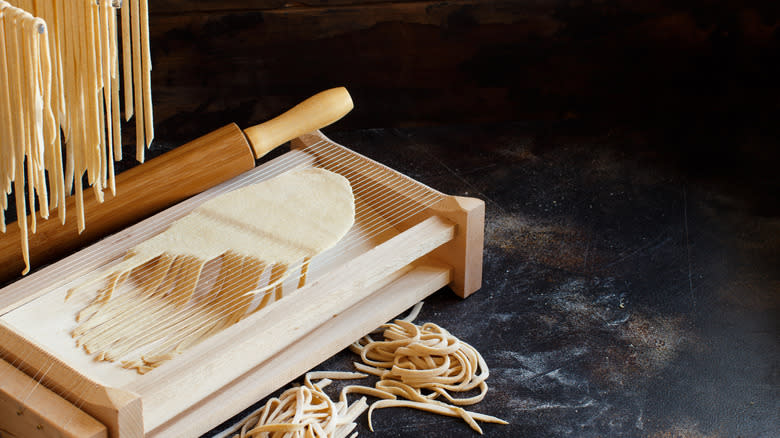
Native to the mountainous region of Abruzzo, spaghetti alla chitarra is slightly thick strands traditionally made using a beechwood instrument outfitted with parallel steel wires, a prime tool for the best homemade pasta prep. This tool, in which the pasta dough is carefully placed over the steel wires and then gently and evenly rolled over with a rolling pin, resembles a primitive chitarra, a guitar, hence the pasta's name.
While spaghetti alla chitarra was born in Abruzzo, it has spread to neighboring regions and picked up new names along the way. In Lazio, the pasta is referred to as Tonnarelli, while in Molise it's known as Cilioli Morizani. Further south, in Puglia and Basilicata, they're known as Truccoli, Torchioli, or even Troccoli.
With so much variation, the pasta is naturally a versatile cut and can be paired with any number of sauces, however the most popular is a fragrant tomato and meat-based sauce. This can range from a sheep ragù or with pallottine, little meatballs that can be made from egg and cheese, lamb, or beef. The result is a filling meal with hearty egg-based pasta and chunks of meat soaked in a juicy tomato sauce.
Ruote Pazze
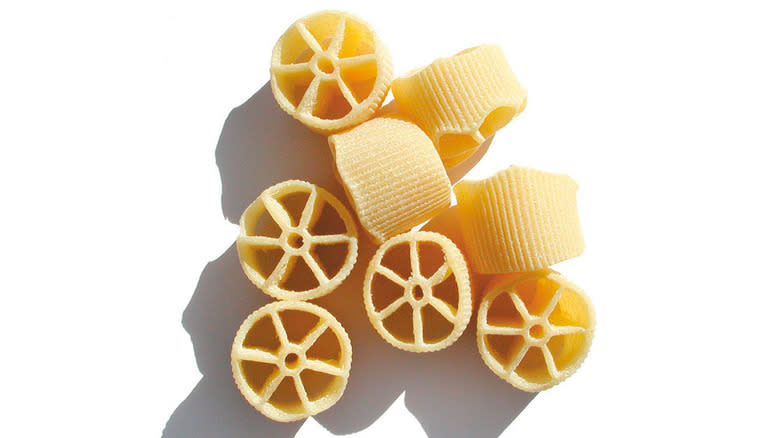
Translating to "crazy wagon wheels," ruote pazze is a cut of pasta that was invented in Lecce, a city located in the region of Apulia (otherwise known as the bit that makes up Italy's heel). The Benedetto Cavalieri family has been growing wheat in the region since the early 19th century. The pasta makers first opened their mill and pasta factory in 1918, where ruote pazze was born.
When cooked, this zany pasta shape doesn't lose its structure but instead remains rigid, allowing for saucy to easily slide through and cling to its spokes. This may be due to the Benedetto Cavalieri's signature delicato, as in delicate method, in which water and durum wheat are kneaded and molded by a bronze alloy and then left to gradually dry at room temperature. The slower and typically lower heat process also allows the pasta to conserve the durum wheat's nutritional value.
Radiatori
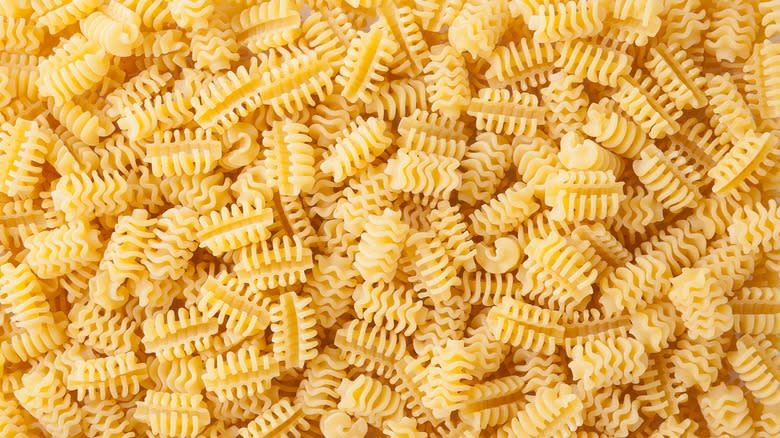
A close cousin to the ultra-popular fusilli, radiatori, translating to "radiators," is a unique pasta shape with wavy grooves on one side and a concave body on the other. Because of its short, squat nature and ruffled edges, radiatori is ideal for holding onto thicker and creamier sauces, ensuring that each bite is packed with flavor. It can be easily substituted for any fusilli dish for a more eclectic and fun meal.
As is the case with many pasta shapes, this radiator-shaped pasta has debated origins and is overall a relatively new player in the pasta game. Some believe it was developed sometime between the two World Wars as an ode to the old-fashioned steam radiators that kept the country's homes and apartments warm. However, the most popular theory is that it was developed in the mid-20th century with the luxury automotive industry in mind and is a specific reference to the grill of a 1960s Bugatti car.
Cavatappi
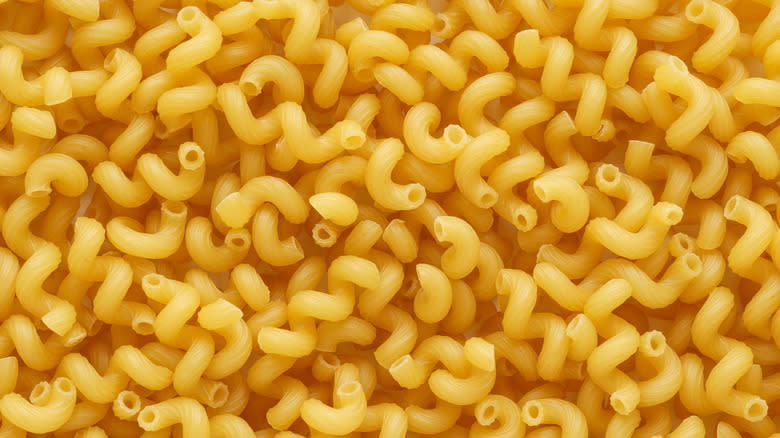
Cavatappi, meaning "corkscrews," is a popular pasta shape perhaps better known in the United States as elbows. It's a thin and hollow spiral-shaped pasta that's part of the macaroni family. The word "macaroni" is descended from the Italian word maccheroni, which means to crush and supposedly references the way pasta was originally made by crushing wheat.
This whimsical, spring-like pasta shape only came onto the scene in the 1960s, when it was created to pay homage to Italian pop singer Adriano Celentano, hence the pasta also being known as cellentani. Celentano was beloved not only for his voice but also for his lithe and energetic dance moves, which earned him the nickname of molleggiato, meaning spring-like, which inspired cavatappi's unique shape.
Due to its slender, spiraled shape, the pasta is multifaceted and pairs delightfully with sauces. It goes even better baked into casseroles and tossed in a cold salad with fresh vegetables and lean proteins such as chicken and turkey. Made only with semolina flour and water, cavatappi is a light and refreshing pasta cut that can be used for heavier meat ragùs, primavera salads, or baked feta pasta casseroles.
Umbricelli
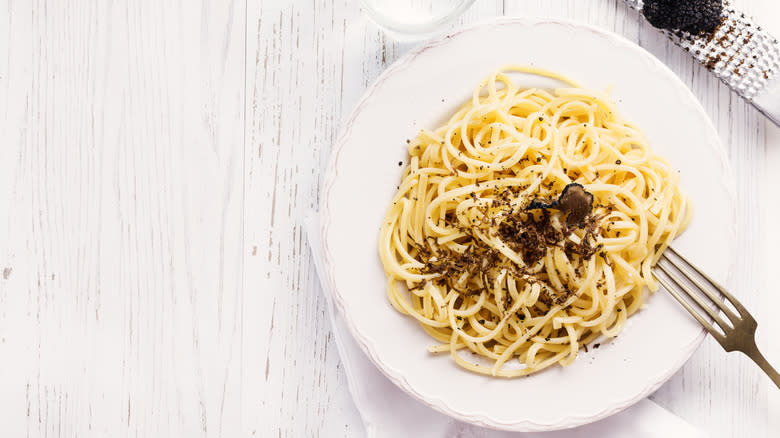
This chewy pasta is a thicker and doughier version of spaghetti that is indigenous to the region of Umbria. Made only with durum wheat and water, umbricelli is also known by another name: strangozzi. Strangozzi were once leather laces used to tie shoes in medieval times, although they also doubled as a dark instrument for murder. Between the 16th and 18th centuries, the region of Umbria was subservient to the oppressive Papal State and power-hungry priests were often strangled to death with these innocuous shoelaces by revolutionaries who sought to overthrow their unjust regime. The shape of umbricelli resembles these benign shoe laces-turned-murder-weapons, hence their alternative name.
While this pasta's history shares common threads of anger and revenge with the strozzapreti pasta from the northern Emilia-Romagna region, umbricelli has its own unique shape. The pasta is delicious tossed into rich tomato sauces heaped with plenty of parsley, a thick meat ragù, or also sprinkled with shaved black truffles, which grow in abundance in the region, to create an earthy, decadent meal.
Umbricelli is recognized by Italy's Ministry of Agricultural, Food, and Forestry Policies as a Prodotto Agroalimentare Tradizionale, an official approval for a traditional agricultural product that is similar to the Protected Geographical Status of the European Union.
Paccheri
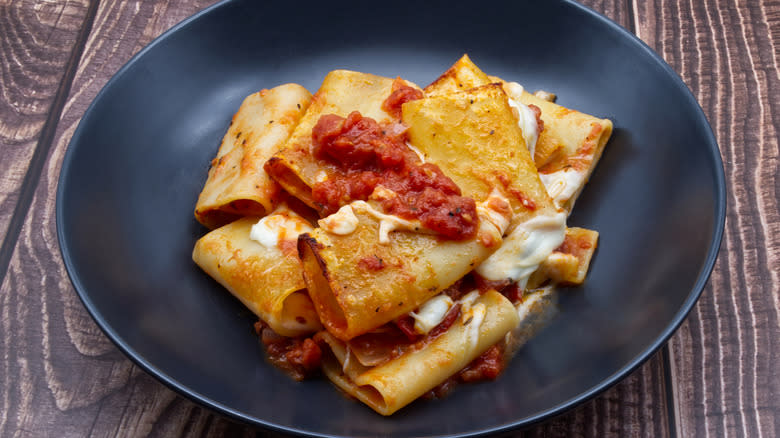
Synonymous with the ancient, bustling city of Naples, paccheri pasta is also known as schiaffoni, which roughly translates to "big slaps." These wide, hollow pasta tubes are often served with thick sauces and seafood, and its large size was once a boon for poor, working-class families who could easily be filled with a small serving.
The origins of the word paccheri are supposedly descended from the slapping sound sauce makes when added to this wide pasa cut. Considering that the Italian word for "slap" is schiaffo, whereas in the Neapolitan dialect it's una pacca, it's easy to see from where the pasta earned both of its names.
According to legend, paccheri was supposedly invented to smuggle garlic cloves into what is modern-day Austria in the 17th century. Southern Italian bulbs were larger and more pungent than their Austrian counterparts, and Austrian aristocrats had such a penchant for them that local garlic production in their country suffered tremendously. To protect their garlic farmers, Austria banned the importation of Italian garlic, much to the chagrin of southern Italian garlic farmers who relied heavily upon their northern clients. The wide hollowness of the paccheri pasta cut was therefore the ideal tool to discreetly circumvent the ban and keep up the illegal, transnational garlic trade.
Pizzoccheri
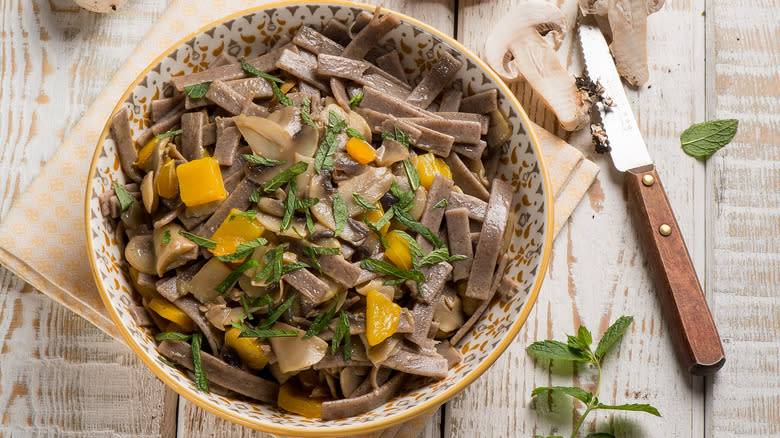
This flat, ribbon pasta is made from buckwheat and is said to hail from the Valtellina valley, located in the northern region of Lombardy. While the valley is ensconced in the shadows of the Alps and is home to a staggering mountainous landscape and extensive vineyards, its high altitude and often freezing temperatures made it hard for medieval farmers to cultivate anything beyond seasonal vegetables during the mild summers and cheeses and cured meats they made from their farm animals. However, despite this unforgiving climate, buckwheat, which is naturally high in gluten, grew in abundance in the area and eventually led to the creation of pizzoccheri.
Pizzoccheri are believed to have burst onto the culinary scene when they were first mentioned in 1550 by Ortensio Lando, a Milanese writer who recorded the various foods of Italy. The pasta was further mentioned in a 1799 book by German historian Heinrich L. Lehmann, who documented a perzockel dough made from buckwheat flour that was served with butter and grated cheese and often consumed by farmers. Today, however, the dish has evolved past its two simple garnishes and is now a more rustic and hearty meal that features cubes of tender potatoes, cabbage, pungent garlic, and fragrant sage. Local cheese is still generously sprinkled over this pasta cut, and the meal continues to be widely enjoyed in its ancestral region.
Cjarsons
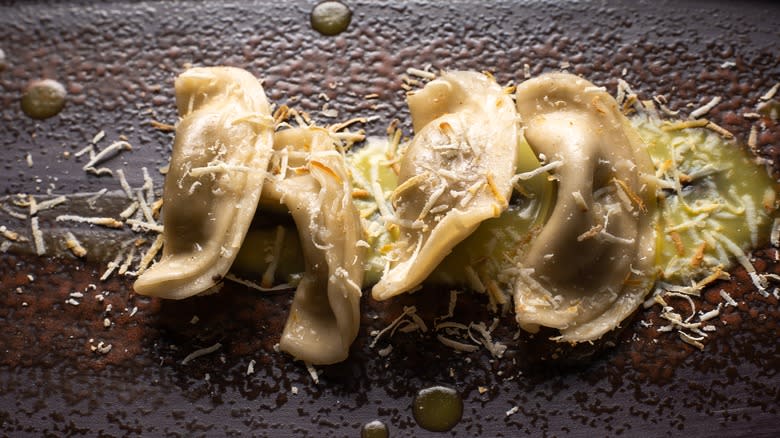
Also known as cjalzons or cjalsonos, cjarsons is a traditional stuffed pasta from Friuli-Venezia Giulia, a northern region that hugs the Adriatic Coast and borders Austria and Slovenia. The pasta is specifically tied to a mountainous cultural enclave within the region called Carnia. Resembling ravioli, cjarsons is traditionally made with flour and water, although some recipes also include potato flour, similar to gnocchi. Fillings, which effortlessly balance sweet and savory, vary by valley and town.
Legends and fairytales enshroud this pasta. One fantastical legend centers around a goblin named Guriùt, who was caught stealing cream from a family's fresh milk. As an apology, the goblin gifted the cjarson recipe. While theories abound, some less folkloric, the stuffed pasta is more realistically believed to have descended from the cramârs, spice merchants who crossed treacherous mountain paths on foot to sell spices in Germany, Austria, and Hungary. When they returned home after many months abroad, their wives used the leftover spices to throw together eclectic fillings for cjarsons in celebration of their homecoming.
Today, cjarsons can be stuffed with almost anything, ranging from mint, parsley, and chives to raisins, cinnamon, and figs. The sweet and savory mixtures are virtually endless, making them one of the country's most versatile stuffed pastas.
Read the original article on Tasting Table.

